AMD’s Radeon HD 6870 & 6850: Renewing Competition in the Mid-Range Market
by Ryan Smith on October 21, 2010 10:08 PM ESTLast but not least in our look at AMD’s new Radeon 6800 series is our look at power consumption, GPU temperatures, and the amount of noise generated. With efficiency being one of the major design goals for Barts, AMD stands to gain a lot of ground here compared to the 5800 series for only a minor drop in performance.
Looking quickly at the voltages of the 6800 series, we have 4 samples – 2 each of the 6870, and 2 each of the 6850. Both of our 6870 cards have an idle voltage of 0.945v and a load voltage of 1.172v, and seeing as how they’re both based on AMD’s reference design this is what we would expect for a design that is based around a single VID.
However our 6850 results, which include a non-reference card in the form of XFX’s customized 6850, are much more interesting. While our reference 6850 has a load voltage of 1.094v, our XFX card reports a load voltage of 1.148v. We’ll be taking a look at the XFX 6850 in-depth next week in our 6850 roundup, but for now this leaves us with the question of whether AMD is using variable VIDs, or if XFX is purposely setting theirs higher for overclocking purposes.
| Radeon HD 6800 Series Load Voltage | |||||
| Ref 6870 | XFX 6870 | Ref 6850 | XFX 6850 | ||
| 1.172v | 1.172v | 1.094v | 1.148v | ||
Finally our EVGA GTX 460 1GB FTW card has a VID of 0.975v, which compared to all the other GTX 460 cards we’ve tested thus far makes it quite notable. This is lower than any of those other cards by 0.012v, a property we believe is necessary to sell such a heavily overclocked card without causing a similarly large rise in power/heat/noise. It’s also for this reason that we question whether NVIDIA could actually supply suitable GF104 GPUs in high volumes, as GPUs capable of running at this voltage are likely coming from the cream of the crop for NVIDIA.
For our tests, please note that we do not have a pair of reference 6850s. For our second 6850 we are using XFX’s customized 6850 card, which means our results will undoubtedly differ from what a pair of true reference cards would do. However as the 6850 reference design will not be widely available this is less important than it sounds.
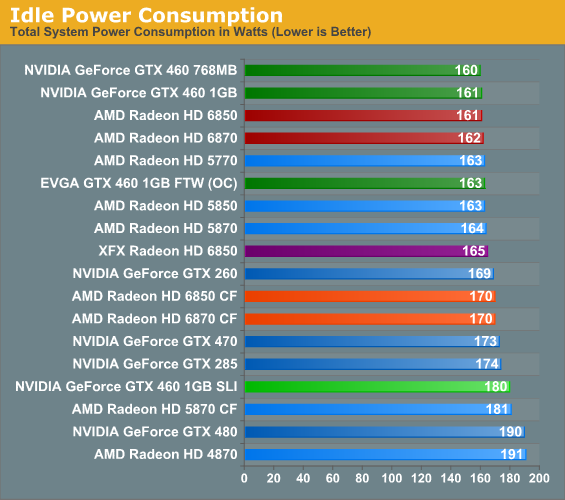
As always we start our look at power/temp/noise with our look at idle power. Because we use a 1200W PSU in our GPU test rig our PSU efficiency at idle is quite low, leading to the suppression of the actual difference between cards. But even with this kind of suppression it’s still possible to pick out what cards have a lower idle power draw, as the best cards will still result in a total system power draw that’s at least a couple of watts lower.
AMD’s official specs call for the 6800 series to have a lower idle power draw than the 5800 series, and while we can’t account for all 8 watts we do manage to shave a couple of watts off compared to our 5800 series cards. The Crossfire results are even more impressive, with the 6870CF drawing 11W less than the 5870CF.
Compared to the 6800 series the GeForce GTX 460 768MB does manage to hang on to top honor here for a single card by a watt, however in SLI our 1GB cards do worse than our 6800 series cards by 10W.
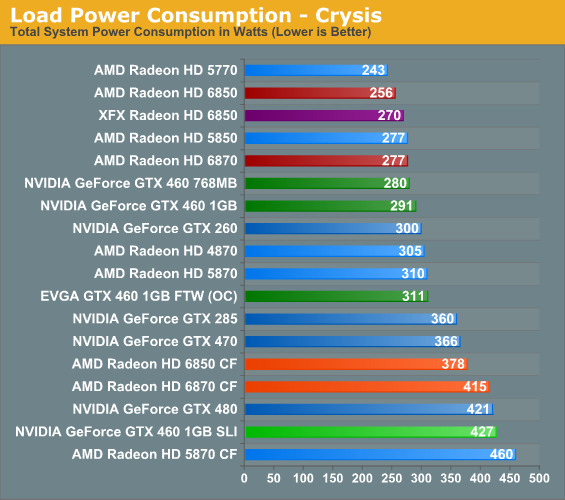
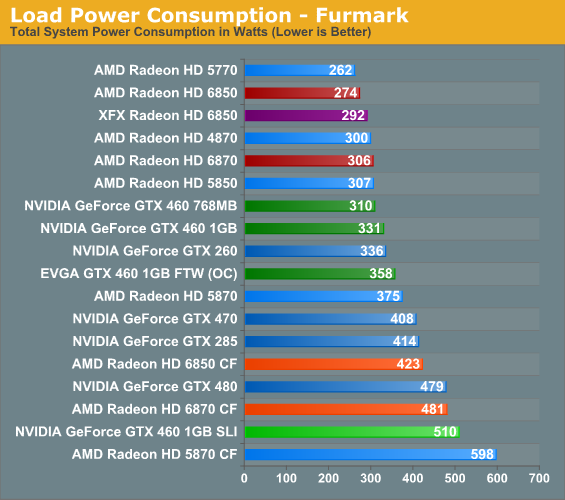
Looking at load power consumption it’s clear from the start that AMD’s efficiency gains are going to pay off here. On the latest iteration of our power consumption chart the 6850 underconsumes even the already conservative 5850 by 20W under Crysis and 25W under FurMark, showcasing how AMD was able to reduce their power consumption by a significant amount while giving up much less in the way of performance.
Compared to the 6800 series NVIDIA does notably worse here, with all of the GTX 460 cards pulling down more power than the 6870 and the GTX 470 being in a league of its own. While NVIDIA was competitive with Cypress on power, they’re not in a position to match Barts. They can deliver Barts-like performance (and then some), but they have to consume more power to do it.
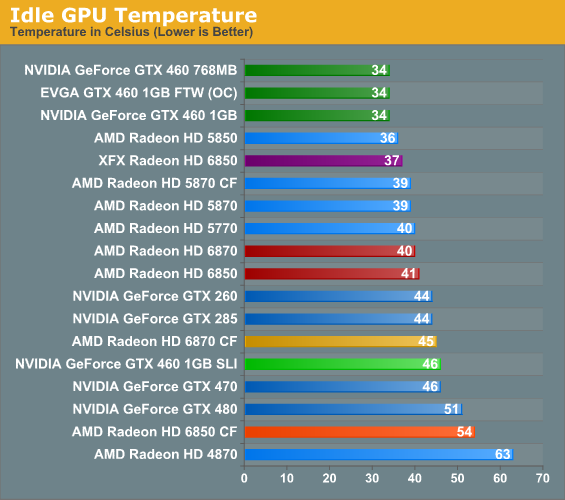
Up next is our look at GPU temperatures, starting with idle temps. As we mentioned in our GTX 460 review, NVIDIA ended up producing a very effective reference cooler for the GTX 460, utilizing an open-air design that by dissipating air inside and outside of the case is capable of reaching temperatures fully exhausting coolers can’t match. As a result all of the GTX 460 cards top our charts here.
Prior to the GTX 460 series this is a metric the 5850 always did well in, so we had expected a similar performance from the 6850, only to leave disappointed. What we’re ultimately looking at is a matter of the quality of the cooler: the 6850 may consume less power than the 5850 at idle, but it packs a weaker cooler overall, allowing it to approach these temperatures. For a gaming card such as the 6800 series idle temperatures are almost entirely superficial once we get below 50C, but even so this tells us something about the 6850 reference cooler.
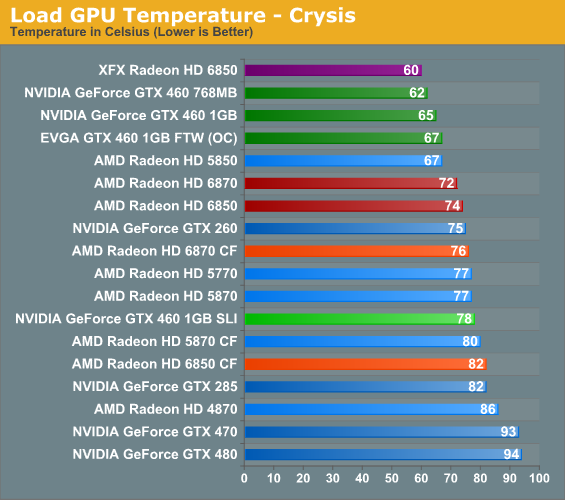
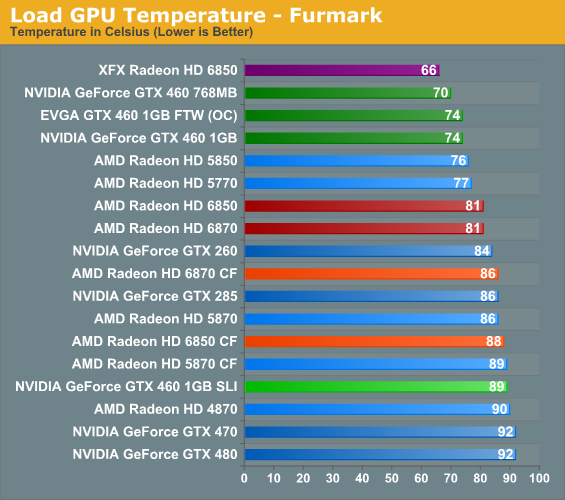
Thanks to the GTX 460’s open-air cooler, all of our GTX 460 cards top our temperature chart even with their higher power consumption. The trade-off is that all of these cards require a well-ventilated case, while the Radeon 5800 and 6800 series will tolerate much poorer cases so long as there’s enough ventilation for the card to pull in air in the first place.
As was the case with idle temperatures, the reference 6850 ends up doing worse than the 5850 here thanks to its less effective cooler; however the 6870 ends up doing better than both the 6850 and 5870 due to its more effective cooler and its lower power consumption compared to the 5870. While these cards can’t quite touch the GTX 460 series, we’re still looking at some of the coolest cards among our current benchmark suite.
Meanwhile our XFX 6850 ends up doing the best out of all of our cards here, however this will come at a cost of more noise. We'll touch on this more next week in our 6850 roundup.
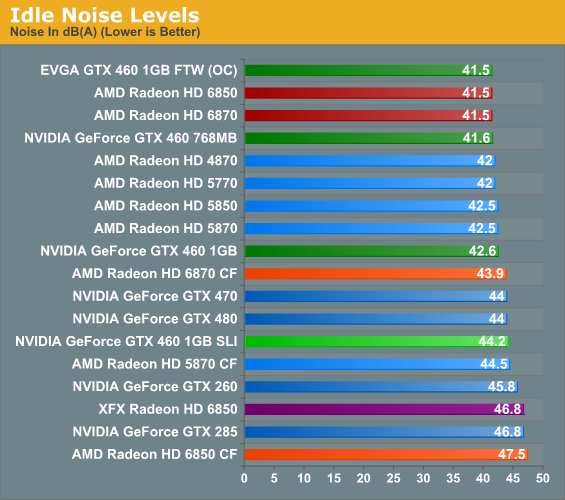
Last but not least is idle noise, which isn’t much of a story with modern cards. With the exception of the GTX 470/480, the latest GeForce and Radeon cards are both capable of running up against the noise floor of our testing environment.
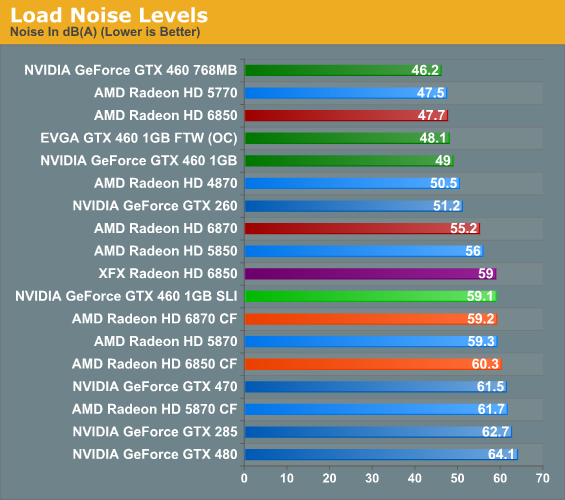
Under load we once again see an NVIDIA GTX 460 card top the chart thanks to its open-air design. This is followed very closely however by the Radeon 6850, which at 47.7dB is our third-quietest card and finally showing off the advantages of the tradeoffs AMD made with the reference cooler. The 6850 may not be as cool as the 5850, but it’s quite a bit quieter. As for the XFX card, this is where XFX has to pay the piper, as their 6850 card ends up being as loud as a 5870 in exchange for their lower temperatures.
Meanwhile the 6870 ends up being quite a bit louder than both the GTX 460 series and the 6850, coming in at 55.2dB. This is a definite leg-up compared to the 5870 and nicely cements the fact that the 6870 is intended to be the 5850’s replacement, but it means the GTX 460 series spoils the results here. Once custom-design vendor cards come out for the 6870, I suspect we’re going to see someone quickly sell a 6870 with a less aggressive cooler, which for the costs of higher temperatures would afford less noise.










197 Comments
View All Comments
Donkey2008 - Friday, October 22, 2010 - link
Can you provide a link to your website so I can read your review of the cards? That would be awesome.Natfly - Friday, October 22, 2010 - link
Sure, right here: http://tinyurl.com/36ag36dBlendMe - Friday, October 22, 2010 - link
So you're telling me I can get two 6870 and spend lest money, use less power and have more performance than a GTX 480? I like the idea of going back to what made the 48xx cards so great. Small, cheap and expandable.Can't wait for the rest of the line up.
tpurves - Friday, October 22, 2010 - link
how is it that the nvidia cards go UP in framerate when you increase the resolution from 1650 to 1920 and add 4xAA? Did you mix up some test run numbers?mapesdhs - Friday, October 22, 2010 - link
It's a pity the charts don't include SLI results for the EVGA 460. I would like to have seen
how close it came to 470 SLI, given the 470s inferior power, GPU load temp and noise
results. The 470 GPU load temps under Crysis for just one card are particularly scary;
the idea of using two 470s SLI, and even more so oc'ing them, seems like a recipe for
thermal mayhem - alien astronomers with IR telescopes would wonder what the heck
they've spotted. :D
The price drop on the 470 is interesting, but the EVGA 460 still looks like a better buy
because of the power/heat issues, especially so for those considering SLI (as I am),
and also the fact that the EVGA is as good or better than the 6870. This graph is the
one that interests me:
http://images.anandtech.com/graphs/graph3987/33232...
The stock 460 SLI is clearly nowhere near as good as 6870 CF or 470 SLI, but given
a single EVGA 460 matches the 6870, I'd really like to know how two EVGAs perform.
Any chance you could add the data later?
On the other hand, one could assume the 6870 should have some oc'ing headroom,
but toms' review didn't show that much of a gain from oc'd 6870s.
The 6870 here in the UK seems to be about 200 UKP (Aria, Scan), though the XFX
version looks to be an exception (178 from Scan). The EVGA is 174 (Scan, but no
stock yet). For those who don't want to spend that much, the 800MHz Palit Sonic
Platinum 460 has dropped down to only 163 (last week it was 183). I almost bought
two of the Palit cards last week, so I'm glad I waited.
Obviously the pricing is all over the place atm, and likely to wobble all over again
when the next 6xxxx cards are released. Either way, despite the lack of major
performance increases atm, at least there's finally some pricing/value competition.
I think I'll wait until the dust settles re pricing, then decide. Quite likely many others
will do the same.
Ian.
AtenRa - Friday, October 22, 2010 - link
Why did you run at 1920x1200 and not 1920x1080 ??most 1920x1200 monitors are extincted from the market and 1920x1080 is becoming the defacto resolution.
Lunyone - Friday, October 22, 2010 - link
Well with bowing down to nVidia on the selection of "what" GPU to use, you have lost all credibility in my eyes. Even Tom's Hardware took a higher road and agreed to use the "hand picked" GPU, but limited the clocks to near stock settings, so there was a more "real" world comparison. Who nows if this isn't the first time that this has happened at Anandtech. I notice no rebuttals on Anand's part, so I'm guessing that they are quite amazed that people are seeing how one sided this issue is. This article wouldn't affect my purchase, since I look a several sites to draw a conclusion from. But my confidence in quality and fair reporting from Anandtech's reviews have been compromised, IMHO. I don't know if I will put any merit to any on Anand's reviews, time will tell.Sunburn74 - Friday, October 22, 2010 - link
Gee. You know whats all this about Anandtech losing credibility? Nvidia specifically asked them to test one card and the consumer benefits from having this information. Its not like anandtech didn't include the reference gtx460 as well. Anything that tells the consumer more about how valuable his dollar really is, is a good thing imo.I currently have an oced radeon 5850 and it annoyed the hell out of me trying to justify whether or not the extra 30 bucks I eventually ended up paying for it, was worth it. There weren't any reviews at the time you see...
SandmanWN - Friday, October 22, 2010 - link
You can't gauge value of an overclocked card against a stock card. You have no idea what the other card can do. What you are saying is nonsense if you really put two seconds into thinking about what you just said.mindbomb - Friday, October 22, 2010 - link
we are talking about factory oc'd cards.It's not like Anand was playing around in rivatuner.